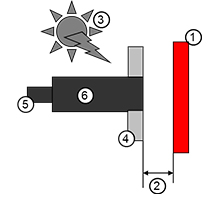
What is the first thing that comes to mind if someone says “proximity sensor?” My guess is the inductive sensor, and justly so because it is the most used sensor in automation today. There are other technologies that use the term proximity in describing the sensing mode, including diffuse or proximity photoelectric sensors that use the reflectivity of the object to change states and proximity mode of ultrasonic sensors that use high-frequency sound waves to detect objects. All these sensors detect objects that are in close proximity to the sensor without making physical contact. One of the most overlooked or forgotten proximity sensors on the market today is the capacitive sensor.
Capacitive sensors are suitable for solving numerous applications. These sensors can be used to detect objects, such as glass, wood, paper, plastic, or ceramic, regardless of material color, texture, or finish. The list goes on and on. Since capacitive sensors can detect virtually anything, they can detect levels of liquids including water, oil, glue, and so forth, and they can detect levels of solids like plastic granules, soap powder, sand, and just about anything else. Levels can be detected either directly, when the sensor touches the medium, or indirectly when it senses the medium through a non-metallic container wall.
Capacitive sensors overview
Like any other sensor, there are certain considerations to account for when applying capacitive, multipurpose sensors, including:

1 - Target
- Capacitive sensors can detect virtually any material.
- The target material's dielectric constant determines the reduction factor of the sensor. Metal / Water > Wood > Plastic > Paper.
- The target size must be equal to or larger than the sensor face.
2 - Sensing distance
- The rated sensing distance, or what you see in a catalog, is based on a mild steel target that is the same size as the sensor face.
- The effective sensing distance considers mounting, supply voltage, and temperature. It is adjusted by the integral potentiometer or other means.
- Additional influences that affect the sensing distance are the sensor housing shape, sensor face size, and the mounting style of the sensor (flush, non-flush).
3 - Environment
- Temperatures from 160 to 180°F require special considerations. The high-temperature version sensors should be used in applications above this value.
- Wet or very humid applications can cause false positives if the dielectric strength of the target is low.
- In most instances, dust or material buildup can be tuned out if the target dielectric is higher than the dust contamination.
4 - Mounting
- Installing capacitive sensors is very similar to installing inductive sensors. Flush sensors can be installed flush to the surrounding material. The distance between the sensors is two times the diameter of the sensing distance.
- Non-flush sensors must have a free area around the sensor at least one diameter of the sensor or the sensing distance.
5 - Connector
- Quick disconnect - M8 or M12.
- Potted cable.
6 - Sensor
- The sensor sensing area or face must be smaller or equal to the target material.
- Maximum sensing distance is measured on metal - reduction factor will influence all sensing distances.
- Use flush versions to reduce the effects of the surrounding material. Some plastic sensors will have a reduced sensing range when embedded in metal. Use a flush stainless-steel body to get the full sensing range.
These are just a few things to keep in mind when applying capacitive sensors. There is not “a” capacitive sensor application – but there are many which can be solved cost-effectively and reliably with these sensors.
